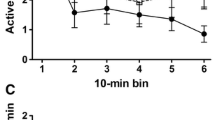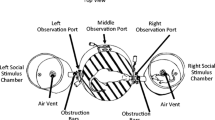Abstract
Rationale
It is necessary to understand better how chronic food restriction (CFR) and psychostimulant drugs interact in motivated behavior unrelated to food or energy homeostasis.
Objectives
We examined whether CFR augments methylphenidate (MPH)-potentiated responding reinforced by visual sensation (VS) and whether repeated MPH injections or prolonged CFR further augments such responses.
Methods
Before starting the following experiments, rats on a CFR diet received a limited daily ration in such a way that their body weights decreased to 85–90% of their original weights over 2 weeks. In experiment 1, rats on CFR and ad libitum diet received four injections of varying MPH doses (0, 2.5, 5, and 10 mg/kg). In experiment 2, CFR and ad libitum groups received repeated injections of MPH (2.5 mg/kg). In experiment 3, half of CFR rats received repeated injections of MPH (2.5 mg/kg), and the other half received saline, and following a 7-day abstinence, they all received the 2.5-mg/kg dose of MPH.
Results
CFR rats increased VS-reinforced responding more than ad libitum rats when they received MPH. Repeated injections of MPH with prolonged CFR further increased VS-reinforced responding. We found a double dissociation where prolonged CFR (3 vs. 6 weeks) made VS-reinforced responding, but not locomotor activity, more responsive to MPH, whereas repeated MPH injections made locomotor activity, but not VS-reinforced responding, more responsive to MPH.
Conclusions
CFR markedly potentiates effects of MPH on VS-reinforced responding. The present study demonstrates that the longer CFR continues, the greater psychostimulant drugs augment behavioral interaction with salient stimuli.




Similar content being viewed by others
References
Beninger RJ, Ranaldi R (1992) The effects of amphetamine, apomorphine, SKF 38393, quinpirole and bromocriptine on responding for conditioned reward in rats. Behav Pharmacol 3:155–163
Blackburn JR, Pfaus JG, Phillips AG (1992) Dopamine functions in appetitive and defensive behaviours. Prog Neurobiol 39:247–279
Butler RA (1957) The effect of deprivation of visual incentives on visual exploration motivation in monkeys. J Comp Physiol Psychol 50:177–179
Cabeza De Vaca S, Krahne LL, Carr KD (2004) A progressive ratio schedule of self-stimulation testing in rats reveals profound augmentation of d-amphetamine reward by food restriction but no effect of a “sensitizing” regimen of d-amphetamine. Psychopharmacology 175:106–113
Carr KD (2007) Chronic food restriction: enhancing effects on drug reward and striatal cell signaling. Physiol Behav 91:459–472
Carr KD (2016) Nucleus accumbens AMPA receptor trafficking upregulated by food restriction: an unintended target for drugs of abuse and forbidden foods. Curr Opin Behav Sci 9:32–39
Carroll ME, Lac ST (1997) Acquisition of IV amphetamine and cocaine self-administration in rats as a function of dose. Psychopharmacology 129:206–214
D’Cunha TM, Sedki F, MacRi J, Casola C, Shalev U (2013) The effects of chronic food restriction on cue-induced heroin seeking in abstinent male rats. Psychopharmacology 225:241–250
Donny CE, Caggiula RA, Mielke MM, Jacobs SK, Rose C, Sved FA (1998) Acquisition of nicotine self-administration in rats: the effects of dose, feeding schedule, and drug contingency. Psychopharmacology 136:83–90
Flagel SB, Akil H, Robinson TE (2009) Individual differences in the attribution of incentive salience to reward-related cues: implications for addiction. Neuropharmacology 56(Supplement 1):139–148
Gainetdinov RR, Wetsel WC, Jones SR, Levin ED, Jaber M, Caron MG (1999) Role of serotonin in the paradoxical calming effect of psychostimulants on hyperactivity. Science 283:397–401
Gancarz AM, San George MA, Ashrafioun L, Richards JB (2011) Locomotor activity in a novel environment predicts both responding for a visual stimulus and self-administration of a low dose of methamphetamine in rats. Behav Process 86:295–304
Harlow HF (1950) Learning and satiation of response in intrinsically motivated complex puzzle performance by monkeys. J Comp Physiol Psychol 43:289–294
Hill RT (1970) Facilitation of conditioned reinforcement as a mechanism of psychomotor stimulation. Amphetamine and Related Compounds: 781–795
Hunt T, Amit Z (1987) Conditioned taste aversion induced by self-administered drugs: paradox revisited. Neurosci Biobehav Rev 11:107–130
Ikemoto S (2002) Ventral striatal anatomy of locomotor activity induced by cocaine, D-amphetamine, dopamine and D1/D2 agonists. Neuroscience 113:939–955
Ikemoto S (2010) Brain reward circuitry beyond the mesolimbic dopamine system: a neurobiological theory. Neurosci Biobehav Rev 35:129–150
Ikemoto S, Panksepp J (1999) The role of nucleus accumbens dopamine in motivated behavior: a unifying interpretation with special reference to reward-seeking. Brain Res Rev 31:6–41
Keller KL, Vollrath-Smith FR, Jafari M, Ikemoto S (2014) Synergistic interaction between caloric restriction and amphetamine in food-unrelated approach behavior of rats. Psychopharmacology 231:825–840
Kelley AE, Gauthier AM, Lang CG (1989) Amphetamine microinjections into distinct striatal subregions cause dissociable effects on motor and ingestive behavior. Behav Brain Res 35:27–39
Kish GB (1966) Studies of sensory reinforcement. In: Honig WK (ed) Operant behavior: areas of Research and application. Appleton-Century-Crofts, Prentice-Hall, Englewood Cliffs, pp 109–159
Kuczenski R, Segal DS (1997) Effects of methylphenidate on extracellular dopamine, serotonin, and norepinephrine: comparison with amphetamine. J Neurochem 68:2032–2037
McCay CM, Crowell MF, Maynard LA (1935) The effect of retarded growth upon the length of life span and upon the ultimate body size. J Nutr 10:63–79
McDonald JH (2014) Handbook of biological statistics, 3rd edn. Sparky House Publishing, Baltimore
Mead AN, Crombag HS, Rocha BA (2003) Sensitization of psychomotor stimulation and conditioned reward in mice: differential modulation by contextual learning. Neuropsychopharmacology 29:249–258
Mistlberger RE (1994) Circadian food-anticipatory activity: formal models and physiological mechanisms. Neurosci Biobehav Rev 18:171–195
Montgomery KC (1954) The role of the exploratory drive in learning. J Comp Physiol Psychol 47:60–64
Parker LA (1995) Rewarding drugs produce taste avoidance, but not taste aversion. Neurosci Biobehav Rev 19:143–151
Pavlov IP (1927) Conditioned reflexes: an investigation of the physiological activity of the cerebral cortex. Oxford University Press, Oxford
Pothos EN, Creese I, Hoebel BG (1995) Restricted eating with weight loss selectively decreases extracellular dopamine in the nucleus accumbens and alters dopamine response to amphetamine, morphine, and food intake. J Neurosci 15:6640–6650
Robbins TW (1975) The potentiation of conditioned reinforcement by psychomotor stimulant drugs. A test of Hill’s hypothesis. Psychopharmacologia 45:103–114
Robinson TE, Berridge KC (1993) The neural basis of drug craving: an incentive-sensitization theory of addiction. Brain Res Rev 18:247–291
Schwartz MW, Woods SC, Porte D Jr, Seeley RJ, Baskin DG (2000) Central nervous system control of food intake. Nature 404:661–671
Shalev U (2012) Chronic food restriction augments the reinstatement of extinguished heroin-seeking behavior in rats. Addict Biol 17:691–693
Shalev U, Grimm JW, Shaham Y (2002) Neurobiology of relapse to heroin and cocaine seeking: a review. Pharmacol Rev 54:1–42
Shin R, Cao J, Webb SM, Ikemoto S (2010) Amphetamine administration into the ventral striatum facilitates behavioral interaction with unconditioned visual signals in rats. PLoS One 5:e8741
Stewart J (1960) Reinforcing effects of light as a function of intensity and reinforcement schedule. J Comp Physiol Psych 53:187–193
Stouffer MA, Woods CA, Patel JC, Lee CR, Witkovsky P, Bao L, Machold RP, Jones KT, de Vaca SC, Reith ME, Carr KD, Rice ME (2015) Insulin enhances striatal dopamine release by activating cholinergic interneurons and thereby signals reward. Nat Commun 6:8543
Taylor JR, Horger BA (1999) Enhanced responding for conditioned reward produced by intra-accumbens amphetamine is potentiated after cocaine sensitization. Psychopharmacology 142:31–40
Taylor JR, Jentsch JD (2001) Repeated intermittent administration of psychomotor stimulant drugs alters the acquisition of Pavlovian approach behavior in rats: differential effects of cocaine, d-amphetamine and 3,4- methylenedioxymethamphetamine (“ecstasy”). Biol Psychiatry 50:137–143
Tucker MJ (1979) The effect of long-term food restriction on tumours in rodents. Int J Cancer 23:803–807
Vollrath-Smith FR, Shin R, Ikemoto S (2012) Synergistic interaction between baclofen administration into the median raphe nucleus and inconsequential visual stimuli on investigatory behavior of rats. Psychopharmacology 220:15–25
Webb SM, Vollrath-Smith FR, Shin R, Jhou TC, Xu S, Ikemoto S (2012) Rewarding and incentive motivational effects of excitatory amino acid receptor antagonists into the median raphe and adjacent regions of the rat. Psychopharmacology 224:401–412
Wise RA, Munn E (1993) Effects of repeated amphetamine injections on lateral hypothalamic brain stimulation reward and subsequent locomotion. Behav Brain Res 55:195–201
Wise RA, Yokel RA, DeWit H (1976) Both positive reinforcement and conditioned aversion from amphetamine and from apomorphine in rats. Science 191:1273–1275
Wyvell CL, Berridge KC (2001) Incentive sensitization by previous amphetamine exposure: increased cue-triggered “wanting” for sucrose reward. J Neurosci 21:7831–7840
Zuckerman M (1994) Behavioral expressions and biosocial bases of sensation seeking. Cambridge university press
Acknowledgments
The present work was supported by the Intramural Research Program of National Institute on Drug Abuse, National Institutes of Health. Celine Nicolas was supported by the NIDA-INSERM Drug Abuse Research Fellowship.
Author information
Authors and Affiliations
Corresponding author
Ethics declarations
Financial disclosures
The authors have no financial disclosure to make.
Electronic supplementary material
Online Resource 1
(DOCX 71 kb)
Rights and permissions
About this article
Cite this article
Talishinsky, A.D., Nicolas, C. & Ikemoto, S. Interaction of chronic food restriction and methylphenidate in sensation seeking of rats. Psychopharmacology 234, 2197–2206 (2017). https://doi.org/10.1007/s00213-017-4625-6
Received:
Accepted:
Published:
Issue Date:
DOI: https://doi.org/10.1007/s00213-017-4625-6




